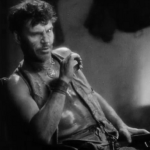 |
 |
 |
| Flint Walter Huston |
Kingsland Conrad Nagel |
Ann Whitehall Virginia Bruce |
 |
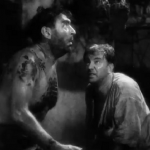 |
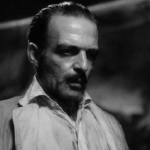 |
| Tula Lupe Velez |
Hogan Mitchell Lewis |
Gregg C. Henry Gordon |
| Released by MGM | Directed By William J. Cowen |
||
Proof That It’s Pre-Code
- Lupe Velez enters the movie in thin strips of cloth.
- Flint likes calling the natives ‘bushrats’ and dropping lines like, “Get the rest of those sons of bushrats off my stoop!”
- The effeminate cook Cookie and Hogan have a giggle because they provide the natives kerosene rather than booze.
- “Well I’ll be d–“
- The movie has more than its fair share of gruesome moments, from a man having his chest cut open, to a barely-off-screen surgery, to lots of other horrifying things that I will soon delve into.
- Such as white slavery, drug addiction, and a lot of really perverse shit… and more!
Kongo: Heartless Darkness
“How did the Almighty ever allow a thing like you on this earth?!”
Kongo is not a pleasant movie. It is not a happy one, no matter what the last reel wants you to think. And its main character, Flint, is the cause of all of that.
The first shot of Flint puts him next to a monkey, both of whom peer down from a loft with scowls on their faces. If Flint doesn’t immediately strike you as some barbaric remnant of our ape ancestors, don’t worry, it doesn’t take long to follow up and show you that his primitive looks are outshone by his temperament.
Deep in the center of the Kongo jungle, Flint rules supreme. His mansion is populated by himself, his monkey named Kong, two flunkie assistants, and Tula, an oversexed Portugeuse woman. There’s a built-in bar that encourages the copious amounts of liquor that keeps everyone going while Flint bosses around the local tribe by way of simple magic tricks and sugar lumps. He’s insinuated himself into the native’s religion, making himself a voodoo doctor who has his own private coterie at his beck and call.
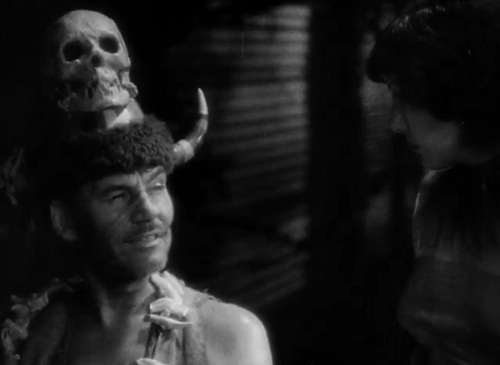
Flint wearing his swag.
Flint smiles as he clambers into his wheelchair and pulls on his ceremonial hat, fashioned out of a human skull.
“Have you ever seen such an Adonis?”
One night, after Flint performs his act for the natives (including the reliable “flaming bowl becomes a bird” trick), he brings one of his henchman, Hogan, to his loft. There he unveils his plan, the 20 year old scheme to revenge himself on the man who paralyzed him and stole his wife. His vengeance on the man, Gregg– “The Man Who Sneered”– is, to use an overused word, diabolical. For eighteen years, he’s kept Gregg’s daughter, Anne, in a convent some ways away. All the while, he’s had the nuns not just instill in her a sense of virtue, but a belief that her father is a missionary doing God’s work in the Congo.
Hogan goes to fetch the girl dressed as a preacher, and it’s hard not to appreciate the irony as he notes, “But we may rejoice what your father and my comrade has conquered for civilization.”

Unheard prayers.
Anne is beautiful, young, and most decidedly virginal. “I must go say goodbye to everyone,” she smiles. But the first, and most symbolical thing she does is kneel and do the sign of the cross. With a smile of pure innocence, she says:
“I hope my father will love me.”
Knowing what crushing horrors await her– only compounded once we flash forward two years and see the extent of Flint’s degradations that included a torrid stint as a sex slave and disease before he brings her back to his jungle lair– probably make this the ideal time to bring up the religious aspect of the story. Anne is on the side of God and holiness, which is until she heads into the heart of darkest Africa. There, Flint has fashioned himself a god, an Old Testament figure of vengeance and hate. He debases her, eager to make her the worst kind of woman and break her spirit. His fiefdom’s subjects are equally as ugly as him, with Hogan taking Anne into a room and violently assaulting her while Flint stays outside, laughing at the top of his lungs. Even Kong the monkey develops a fondness for her– Flint’s perverse hold on the area has tainted everything, even blurring the lines between the species.
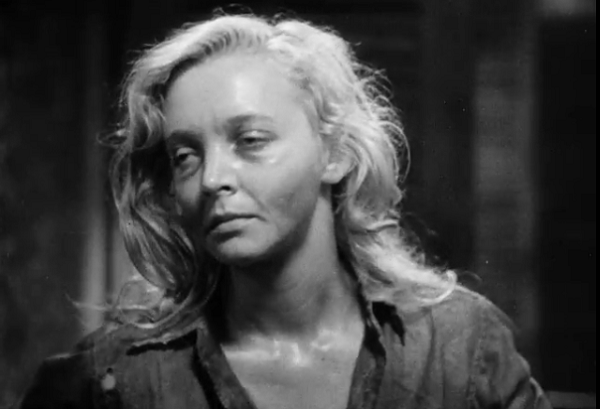
Two years in a Zanzibarian whorehouse, booze, and disease can really do wonders for your complexion.
But if Anne is some representation of purity, than she needs a savior (or Savior, if you’re into such things). Things at the mansion of the damned take a dramatic turn when Dr. Kingsland arrives at the remote outpost. He’s a ‘byang root’ addict, noting with as much of a smile as he can muster, “I came to fight this drug, and one day I just stopped fighting it.” He’s clearly blitzed out of his mind, but when he sees Anne, something slips through the haze. He’s smitten. Chuckling, Flint turns to Hogan:
“Looks like our little lady is having another romance.”
“She’s had so many, one more won’t make a difference.”
But the first person Kingsland has to save is himself, and he fails this test horribly. Velez’s Tula plays the men against each other for favoritism and, naturally, all the sex she can get. All she needs to do is pass along some byang root and she’ll get Kingsland to do her bidding. They both indulge, leading to Anne discovering, to her horror, him partying in a room with Tula and a bunch of strung out natives. It’s a scene of pagan madness, but it manages to steel Anne’s reserves and show her that she still has the grace within her to survive.
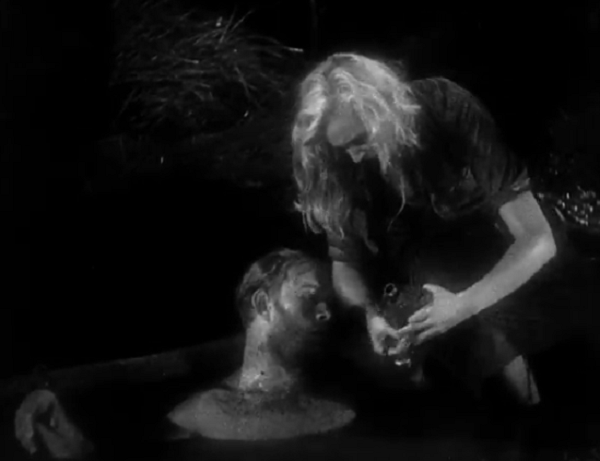
First come the leeches, then comes the love!
Lucky for Kingsland, Flint needs his services to help fix a lingering pain in his back. He decides to cure Kingsland’s addiction by tying him to a pole out in the swamp and then “let the leeches do the rest” (for those considering this, I would not advise this drug rehabilitation method being undertaken nowadays without consulting a doctor first). The treatment works, and Kingsland is clean, but is it too late? Flint has finally brought Gregg to the center of his tropical hell, planning on revealing the extent to which he’s tarnished the sneering man’s legacy and then to kill him, enacting an old tribal custom (that he’s encouraged) that will see Anne burned alive as a result. But when Gregg finally shows his face, he reveals that there’s more to Flint’s story than he knew.
Spoilers.
Let’s sidestep that for a moment. Kongo is not the most flattering portrayal of Africans, though I probably don’t need to mention that at this point. Like in other movies, the natives here serve more as a symbolic purpose than as individuals. They’re the zombies of our moderns flicks, a horde of mindless children who obey until it’s time to wreak the third act vengeance. Funnily, the characters actually talk about their feelings for the natives after Gregg arrives. Complaining about the way Flint has his charges attack any white man in their territory, he hisses:
“It’s a dangerous game putting blacks against whites.”
Flint volleys back, with all sincerity:
“No black ever did me the dirt the white man has.”
Gregg is a pretty despicable fellow. He’s tall, proud, and has a twitchy mustache under a big nose. He trades in slave and ivory, much like Flint, but has had the hurt put on him by the wheelchair-bound man’s stranglehold on the deep jungle. When Flint reveals himself to be the man that Gregg paralyzed, Gregghas a flicker of remorse. But when the full extent of Flint’s revenge is revealed, he can only laugh.
You see, Anne is actually Flint’s daughter.
The truth is confirmed quickly. (The fact that Anne was born on Christmas only further draws the line of Kongo being a fable about the power of the real God versus the false one.) Gregg gloats and departs, unaware that the trap has been set and he’ll soon be dead. This dooms Anne as well, and as the savages approach to take her for sacrifice, it’s up to Flint to finally recover what he can of his humanity before its too late. He even prays, finally, to God to protect Anne as he hatches a plan to save her and Kingsland and the rest of the band of bastards he’d terrorized for years.
Here’s the thing about Flint: the film’s final half an hour clearly wants you to sympathize with his transformation from evil to good. That knowledge that he’s committed something so barbaric against his own kin is played out with frightening sorrow in Walter Huston’s eyes.
But here’s the crazier thing about Kongo: the movie actually wants you to sympathize with him from the start. He’s a depraved maniac, but the way things are orchestrated throughout with pointed dramatic ironies and the sheer glee Huston maintains for much of the film indicates that the film is on board with his ugly revenge scheme, up until Kingsland shows up and snaps Anne out of her drunken haze.
This makes Kongo a pretty brutal experience. It’s based on a stage play from 1928, which was turned into a Lon Chaney flick around the same time called West of Zanzibar. The Chaney film, from what I read, added a prologue that shows Flint becoming paralyzed and setting up the horrors that await. I can see why this was needed to make sure the audience didn’t lose sight of Flint’s humanity, but Kongo is a stronger movie becomes it dares you to have sympathy for a guy who commits so much evil. It spits in the face of decency and dares you to ride along with the vicarious thrills that Flint has planned– and then you get the double pleasure of feeling superior once the truth about Anne comes out.
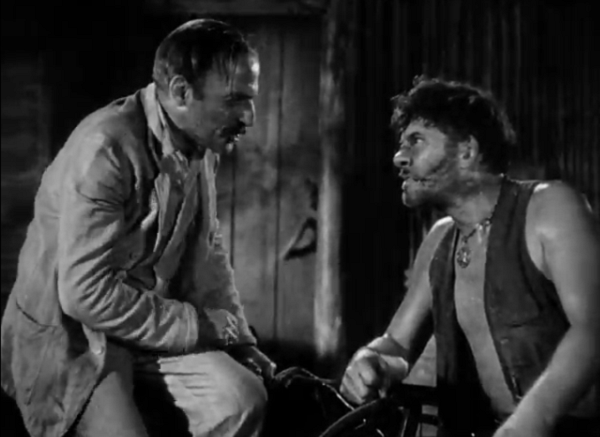
“Grr.” “Arr.”
End spoilers.
Kongo has this great, pulpy atmosphere that’s hard to resist, even as its heart is so utterly black. Most of the film takes place on a nicely claustrophobic set, with natives or other cast members peering in on conversations, and shadows crowding every one in as the jungle outside seems to close in. The dialogue is pointed and delicious, with one moment where a very high Kingsland threatens to shoot his paralyzed jailer.
“I think you’re going to enjoy the sound of lead crashing through your skull, Flint.”
It’s an unrelentingly nasty movie, anchored by Huston who plays Flint as the personification of the devil. The rest of the cast is fine too– yes, even Lupe Velez for once– as everyone gets to let loose and run amok. It’s fascinating to see how dark it gets, and the movie works as a roller coaster ride, a way not only to examine just how depraved a pre-Code movie can be but just how such a movie can suck you in and how far it can take you.
Gallery
Hover over for controls.
Trivia & Links
- Acidemic Film Journal talks about the film’s origins.
Part of the pleasure of the pre-codes is in trying to fathom just how X-rated and lurid they can be; we’re just conditioned from childhood to think of old black and white films as being safe, innocent fun. When we see something like Kongo it’s like having the bottom drop out on all our socialized expectations; like being all prepared for a boring three hour lecture and having the professor start shooting up speed, passing around brandy and reefers, flogging the latecomers, and cutting off the tongues of anyone who talks without raising their hand.
- Krell Laboratories talks about the film’s deeply cruel portrayals of race but how the movie’s honesty about it doesn’t hinder the film:
And yet, it’s interesting as all get out to watch this film without the need to decode its racial underpinnings. It doesn’t hide its essential racism, which makes it a more honest film than something like, say, The Song of the South or Gone With the Wind. Kongo is also possessed of a kind of pulp vitality. Sure, you feel shame for watching it, but, man, let me tell you, you can’t take your eyes off of it. It sets the narrative hooks, and pulls you along for the ride.
- Once Upon a Screen notes their disappointment that there are no maracas in the film, but is stunned by the film’s content.
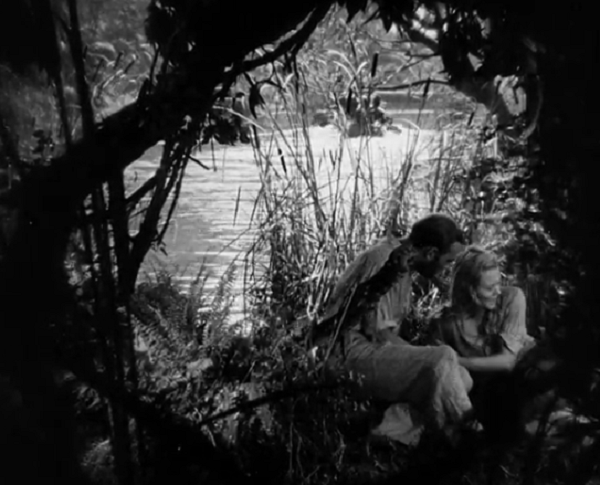
I love this shot, with the doctor and Anne talking in the background while a man heads to his doom (and thus endangering Anne too) in the background.
- TCM’S Movie Morlocks compare this one to Safe in Hell and Rain, as well as commenting on the film’s racism. But the best part may be from the comments where one intrepid poster left a review from Box Office Magazine from the film’s original release.
Kongo (MGM) Reviewed by New England Film News, December 1, 1932
There was less excuse for making this picture than there has been for many other that Metro has turned out. Unpleasant, revolting and disgusting, it offers no entertainment to a depression-ridden public. Its only virtue is the presence of Walter Huston, Conrad Nagel and Virginia Bruce. They do as good a job as possible with the material at hand. But the story is filthy and implausible and has already suffered severely at the hands of the censors. Furthermore, it is unbelievable. Huston is a trader who lives within an 80-mile circle. No one leaves or enters without his knowledge. He was crippled from the waist down by a man who also seduced his wife and in revenge 18 years later he lures the girl who he thinks is his enemy’s daughter to his little empire and treats her brutally. Nagel enters the scene as a degraded doctor and unsuccessful attempts are made by Nagel and the girl to escape. Finally, with the arrival of his old enemy, Huston discovers that the child is his own and to atone for his brutality to her he allows her and the doctor to escape but is killed by the natives. A nice wholesome story, isn’t it, to foist upon the public in the guise of entertainment? Not only is it unsatisfactory for children, it is also unsatisfactory for adults. Here is another for which the exhibitor will do better to pay a bit rather than play it.
SELLING SEATS: Don’t try too hard. There are few people who would like this film. Surround it with a few good shorts, comedies especially, and sell them instead of the feature to your public.
Awards, Accolades & Availability
- This film is available on Amazon and Warner Archive. I caught it over at Warner Archive Instant.
Comment below or join our email subscription list on the sidebar! |
||
 |
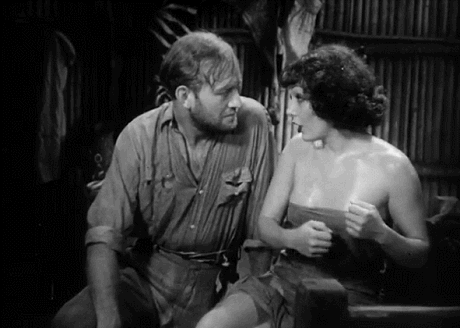 |
 |
 |
 |
|

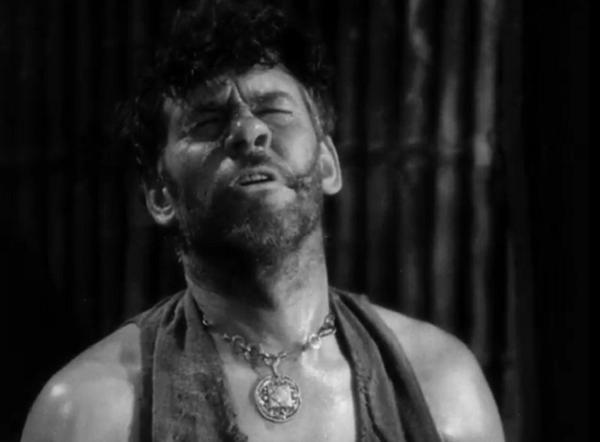
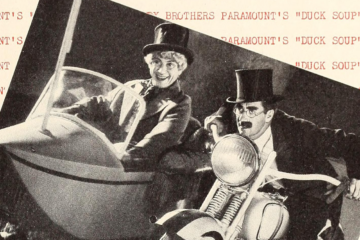


4 Comments
Grand Old Movies · January 12, 2015 at 1:27 pm
This one is REALLY strange – I’ve seen few weirder scenes in pre-Code films that that of Conrad Nagel taking the Leech treatment for drug addiction. What’s in the film’s favor is how it doesn’t pull its punches about what it’s showing or what its characters are like (it’s even less sentimental than the Chaney version, which is also pretty shocking). I just wonder what was the appeal the original story had for audiences, since MGM made a film of it TWICE.
Danny · January 19, 2015 at 8:23 am
I guess if you wanted to make a movie filled with shocking content, this one pretty much had it all. I kind of wish it was more well known; I think showing it to people who think old horror is all creaky Dracula shenanigans would be shocked by it.
Laurie Brown · July 12, 2015 at 12:25 pm
Watched this one because I was a fan of the West of Zanzibar. This version was even grimmer than Zanzibar and I thought Huston was mesmerizing as Flint. Such a dark black film. Love the old pre-code movies, they’re so unexpectedly raunchy. Especially enjoy the Tod Browning / Lon Chaney collaborations, few films are as demented as the things the two of them made together. Makes you wonder what cinema would have been like if the production code had never come into effect, essentially handcuffing film makers for the next 35 years.
Danny · July 16, 2015 at 10:50 am
I definitely wonder that a lot myself.
Comments are closed.